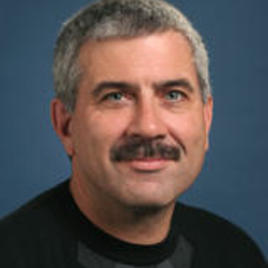
Richard Cardullo
Professor of Biology
Ph.D., The Johns Hopkins University, 1985
Biology 5A, Introduction to Cell and Molecular Biology
Biology 111, Cell Biology
Biology 200A, Graduate Cell and Developmental Biology
Biology 203, Cellular Biophysics
Biology 281E, Seminar in Cell, Development, Structure, and Function
Fertilization is a result of complex molecular interactions between sperm and egg and a complete understanding of these processes is necessary to identify potential sites for contraceptive development as well as specific molecular lesions leading to infertility. Our laboratory is currently employing advanced imaging technologies along with biochemical and biophysical methodologies in order to determine both the molecules involved in fertilization as well as the precise sequence of molecular events ultimately leading to the fusion of mammalian sperm and egg. In particular we have been focusing on three specific aspects of sperm egg interaction:
The characterization of egg-associated proteins with complementary receptors on the sperm surface. The dynamics of the sperm plasma membrane during fertilization. The initiation and characterization of signal transduction pathways leading to the exocytosis of the acrosomal vesicle from sperm.
Using a number of video enhanced microscopic techniques such as fluorescence recovery after photobleaching (FRAP) and fluorescence resonance energy transfer (FRET) we are able to observe these molecular events at the level of the single cell. In addition, we have begun to use these techniques to follow the activation of other cell types and to follow the expression of genes during embryonic development.
Dr. Cardullo participates in the EEOB Graduate Program as well as the Cell, Molecular, and Developmental Biology Graduate Program and IDEA, the UCR Institute for the Development of Educational Applications.
Hutt, D.M., Cardullo, R.A., Baltz, J.M., and Ngsee, J.K. 2002. Synaptotagmin VIII may function in mammalian sperm acrosomal exocytosis. Biol. Reprod. 66:50-56.
Baker, S.S., Cardullo, R.A., and Thaler, C.D. 2002. Sonication of mouse sperm membranes reveals distinct protein domains. Biol. Reprod., 66:57-64.
Thaler, C.D., and Cardullo, R.A. 2002. Dissecting the complex behavior of sperm-zona pellucida interactions: Distinct membrane fractions from mouse sperm bind different zona pellucida glycoproteins. Biol. Reprod., 66:65-69.
Cardullo, R.A. 2002. Principles of Non-Radiative FRET: The Spectroscopic Ruler. Microscopy and Analysis, 53:19-21.
Cardullo, R.A and C. D. Thaler. 2002. Function of the egg extracellular matrix. In: Fertilization (D. Hardy, ed)., Academic Press, pp. 119-152.
Price, M.V. and Cardullo, R.A. 2000. UC must take lead in curricula reform, teacher training. California Agriculture 54:56-62.
Cardullo, R.A. 1999. Characteristics of the sperm-zona interaction: Identifying key issues for determining receptors for ZP3. In: The male gamete: basic biology and clinical applications (C. Gagnon, ed.), Cache River Press, pp. 237-247.
Cardullo, R.A., and S. Dandala. 1999. Correcting for artifacts in complex aqueous solutions when using the pH-sensitive dye 3',7'-bis-(2-carboxyethyl)-5(and-6) carboxyfluorescein. Anal. Biochem. 267(2):351-6.
Cardullo, R.A., and E.J. Alm. 1997. Introduction to Image Processing. Methods in Cell Biology, 56:91-115.
Arnoult, C., Cardullo, R.A., Lemos, J.R., and H.M. Florman. 1996. Activation of mouse sperm T-type Ca2+ channels by adhesion to the zona pellucida. Proc. Natl. Acad. Sci. USA, 93:13004-13009.
Thaler, C.D., and R.A. Cardullo. 1996. The initial interaction between mouse sperm and the zona pellucida is a complex binding event. J. Biol. Chem. 38:23289-23297.
Thaler, C.D., and R.A. Cardullo. 1996. Defining oligosaccharide specificity for initial sperm-zona pellucida adhesion in the mouse. Molec. Reprod. Devel. 45:535-546
Cardullo, R.A., Herrick, S.B., Peterson, M.J., and L.J. Dangott. 1994. Speract receptors are localized on sea urchin sperm flagella using a fluorescent peptide analog. Developmental Biology 162:600-607.